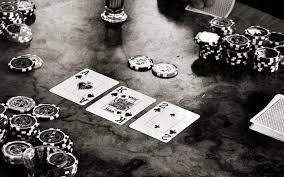Poker is a game of strategy, psychology, and, most importantly, chance. Among the many betting options and techniques used by poker players, one action stands out for its intensity and impact on the game: going “All-in Poker.” In poker, going all-in means betting all of your remaining chips on a single hand. This bold move can drastically shift the course of a game, creating moments of excitement, tension, and high stakes. But how and when should you go all-in? In this article, we’ll explore the concept of going all-in in poker, the strategy behind it, and when it can be the right choice.
What Does “All-in” Mean?
In poker, the term “all-in” refers to a situation where a player bets all of their remaining chips into the pot. This is typically done when a player believes they have the best hand or when they want to take a risk to potentially double their chips (or more) depending on the pot size. Once a player goes all-in, they cannot bet further in that hand unless they have more chips to wager. If multiple players are involved in the hand, those who are not all-in must continue betting according to the usual rules. The player who goes all-in will only compete for the portion of the pot they are eligible for based on their bet size.
Why Do Players Go All-In?
There are several reasons why a player might decide to go all-in:
- Strong Hand: When a player has a powerful hand, such as a royal flush or four of a kind, they may want to maximize their winnings by betting all of their chips. By going all-in, they apply pressure on opponents, potentially forcing them to fold.
- Bluffing: Going all-in can be a strategic bluff to make other players believe that the bettor has a strong hand. If the opponents fold due to fear of the all-in bet, the player who went all-in can win the pot without even showing their cards.
- Desperation: A player who is low on chips or facing elimination might choose to go all-in as a last-ditch effort to stay in the game. The risk is high, but it may be their only option to make a comeback.
- Tournament Strategy: In poker tournaments, the size of your chip stack relative to the blinds and other players can dictate the decision to go all-in. As blinds increase and your chip stack shrinks, going all-in may become a necessary part of the strategy to survive and potentially make it to the final stages.
When Should You Go All-in Poker?
Knowing when to go all-in is a crucial part of poker strategy. The timing of this move can make the difference between a big win and an unfortunate loss. Here are some key moments when going all-in might be the best decision:
- When You Have a Strong Hand: As mentioned earlier, if you have a top-tier hand that’s unlikely to be beaten (e.g., a full house, straight flush, or better), going all-in can maximize your winnings. It’s especially effective if you’re facing an opponent who might be willing to call your bet.
- When You’re in a Tournament and Low on Chips: In tournament play, there comes a point when your chip stack is small relative to the blinds, and you’re at risk of being blinded out. Going all-in can give you a shot at doubling your chips and staying alive in the tournament.
- To Apply Pressure in a Bluff: If you think your opponents are holding weak hands and you want to push them out of the pot, going all-in can often force them to fold. Of course, this requires you to have a good sense of your opponents’ play styles and tendencies.
- When You’re Facing an Opponent Who Might Call: If you’re playing against an opponent who is likely to call your bet regardless of their hand, going all-in can be a way to leverage your stronger position. Even if they call, you’re in a favorable situation.
Risks and Downsides of Going All-in Poker
While going all-in can be thrilling, it’s not without its risks. The main downside is that if your hand is not strong enough and your opponent calls, you could lose all your chips in one fell swoop. Additionally, if you go all-in too frequently, your opponents may catch on to your strategy and adjust their play to counter it.
For example, if you’re bluffing with an all-in bet too often, experienced players will start to recognize the pattern and call your all-ins even when they don’t have a strong hand. Therefore, it’s important to mix up your strategy and use the all-in move sparingly to maintain its effectiveness.
Conclusion
Going all-in in poker is one of the most thrilling aspects of the game, but it’s also one of the most risky. It’s a move that can turn the tide in your favor, but it can also lead to an early exit from the game if you’re not careful. Whether you’re going all-in with a strong hand to maximize your winnings, bluffing to pressure your opponents, or making a desperate push to stay alive in a tournament, the key is to know when the time is right. The best poker players understand the value of going all-in, and they do so strategically, with full knowledge of the risks and rewards involved.

